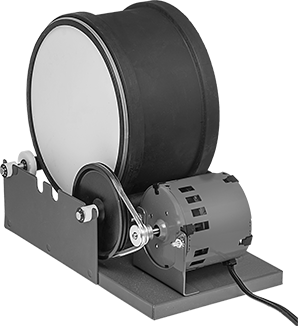Is Tumbling the Right Finishing Process for Your Part?
At KAD, we’re proud to offer a wide range of finishing services, including sandblasting (also known as media blasting), small-part powder coating, hardware installation, and tumbling.
We recently purchased two small tumblers—one for each of our West Coast and East Coast precision machine shops.
Curious if tumbling is right for your prototype model? Keep reading to learn more about this finishing option.
What Is Tumbling for Precision Machined Parts?
Tumbling is a highly effective and efficient finishing method that produces a uniform surface finish without causing damage. Frequently used as a faster alternative to deburring parts by hand, it’s capable of reaching small and hidden areas that may otherwise be difficult to access.
How tumbling works
The act of tumbling is just like it sounds—think about your clothes going through a dryer. We place parts in a hexagonal barrel with a carefully selected tumbling material. (Tumbling materials range from fine walnut shells to abrasive ceramics in the shape of sharks’ teeth.)
The barrel rotates at 150 revolutions per minute while the parts bounce off the sides and connect with the tumbling material to produce a uniform finish.
What to Know About Tumbling vs. Sandblasting
The standard procedure at our precision machine shop is to ship parts as machined. However, if parts are complicated or have rough surfaces, we may talk with the client about tumbling or sandblasting to achieve a better finish.
Here’s what to know about tumbling vs. sandblasting:
Tumbling provides a mottled finish
If you have your heart set on a shiny, smooth, machined finish, tumbling might not be the best option. The process dulls the part’s surface and leaves a mottled appearance that looks nothing like a sandblasted finish.
Tumbling is fast and cost-effective
The more time a precision machine shop must dedicate to finishing a part, the more that part ends up costing. Tumbling is fast and cost-effective compared to alternatives such as deburring parts by hand and sandblasting.
With sandblasting, each individual part must be handled by a finishing specialist. Tumbling, on the other hand, involves simply adding several parts to the tumbler and initiating the process.
Tumbling is good for parts with fine details and tight tolerances
Sandblasting is an abrasive process that not only deforms delicate parts but also adds enough texture to grow a part’s surface and potentially compromise tight tolerances.
While it’s important to be careful when tumbling parts with fine details and features, we can strategically select a fine enough tumbling material (e.g., walnut shells) to finish the parts without causing damage. Furthermore, tumbling won’t grow a part’s surface, making it a great solution for parts with tight tolerances.
Want to put our tumblers to use for your next precision machining project? Request a quote.



